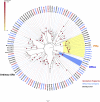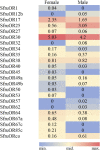Identification and expression analysis of chemosensory receptors in the tarsi of fall armyworm, Spodoptera frugiperda (J. E. Smith)
- PMID: 37101698
- PMCID: PMC10123274
- DOI: 10.3389/fphys.2023.1177297
Identification and expression analysis of chemosensory receptors in the tarsi of fall armyworm, Spodoptera frugiperda (J. E. Smith)
Abstract
Chemosensation of tarsi provides moths with the ability to detect chemical signals which are important for food recognition. However, molecular mechanisms underlying the chemosensory roles of tarsi are still unknown. The fall armyworm Spodoptera frugiperda is a serious moth pest that can damage many plants worldwide. In the current study, we conducted transcriptome sequencing with total RNA extracted from S. frugiperda tarsi. Through sequence assembly and gene annotation, 23 odorant receptors 10 gustatory receptors and 10 inotropic receptors (IRs) were identified. Further phylogenetic analysis with these genes and homologs from other insect species indicated specific genes, including ORco, carbon dioxide receptors, fructose receptor, IR co-receptors, and sugar receptors were expressed in the tarsi of S. frugiperda. Expression profiling with RT-qPCR in different tissues of adult S. frugiperda showed that most annotated SfruORs and SfruIRs were mainly expressed in the antennae, and most SfruGRs were mainly expressed in the proboscises. However, SfruOR30, SfruGR9, SfruIR60a, SfruIR64a, SfruIR75d, and SfruIR76b were also highly enriched in the tarsi of S. frugiperda. Especially SfruGR9, the putative fructose receptor, was predominantly expressed in the tarsi, and with its levels significantly higher in the female tarsi than in the male ones. Moreover, SfruIR60a was also found to be expressed with higher levels in the tarsi than in other tissues. This study not only improves our insight into the tarsal chemoreception systems of S. frugiperda but also provides useful information for further functional studies of chemosensory receptors in S. frugiperda tarsi.
Keywords: Spodoptera frugiperda; expression profile; gustatory receptor; ionotropic receptor; odorant receptor; tarsal transcriptome.
Copyright © 2023 Dong, Yang, Li, Yu and Tian.
Conflict of interest statement
The authors declare that the research was conducted in the absence of any commercial or financial relationships that could be construed as a potential conflict of interest.
Figures









Similar articles
-
Identification and Characterization of Chemosensory Receptors in the Pheromone Gland-Ovipositor of Spodoptera frugiperda (J. E. Smith).Insects. 2022 May 21;13(5):481. doi: 10.3390/insects13050481. Insects. 2022. PMID: 35621815 Free PMC article.
-
A mouthpart transcriptome for Spodoptera frugiperda adults: identification of candidate chemoreceptors and investigation of expression patterns.Front Physiol. 2023 Apr 25;14:1193085. doi: 10.3389/fphys.2023.1193085. eCollection 2023. Front Physiol. 2023. PMID: 37179830 Free PMC article.
-
Candidate chemosensory receptors in the antennae and maxillae of Spodoptera frugiperda (J. E. Smith) larvae.Front Physiol. 2022 Sep 15;13:970915. doi: 10.3389/fphys.2022.970915. eCollection 2022. Front Physiol. 2022. PMID: 36187799 Free PMC article.
-
Identification of Candidate Chemosensory Receptors in the Antennae of the Variegated Cutworm, Peridroma saucia Hübner, Based on a Transcriptome Analysis.Front Physiol. 2020 Jan 31;11:39. doi: 10.3389/fphys.2020.00039. eCollection 2020. Front Physiol. 2020. PMID: 32082194 Free PMC article.
-
Impact of fall armyworm (Spodoptera frugiperda) (J.E. Smith) on small-scale maize farmers and its control strategies in the Limpopo province, South Africa.Jamba. 2021 Oct 27;13(1):1016. doi: 10.4102/jamba.v13i1.1016. eCollection 2021. Jamba. 2021. PMID: 34858557 Free PMC article. Review.
Cited by
-
The conserved IR75 subfamily mediates carboxylic acid detection in insects of public health and agricultural importance.J Insect Sci. 2025 Jan 20;25(1):10. doi: 10.1093/jisesa/ieaf012. J Insect Sci. 2025. PMID: 39891408 Free PMC article. Review.
-
Functional Characterization of an Odorant Receptor Expressed in Newly Hatched Larvae of Fall Armyworm Spodoptera frugiperda.Insects. 2024 Jul 26;15(8):564. doi: 10.3390/insects15080564. Insects. 2024. PMID: 39194769 Free PMC article.
References
-
- Blaney W. M., Simmonds M. S. J. (1990). A behavioural and electrophysiological study of the role of tarsal chemoreceptors in feeding by adults of Spodoptera, Heliothis virescens and Helicoverpa armigera . J. Insect Physiol. 36, 743–756. 10.1016/0022-1910(90)90048-K - DOI
LinkOut - more resources
Full Text Sources

